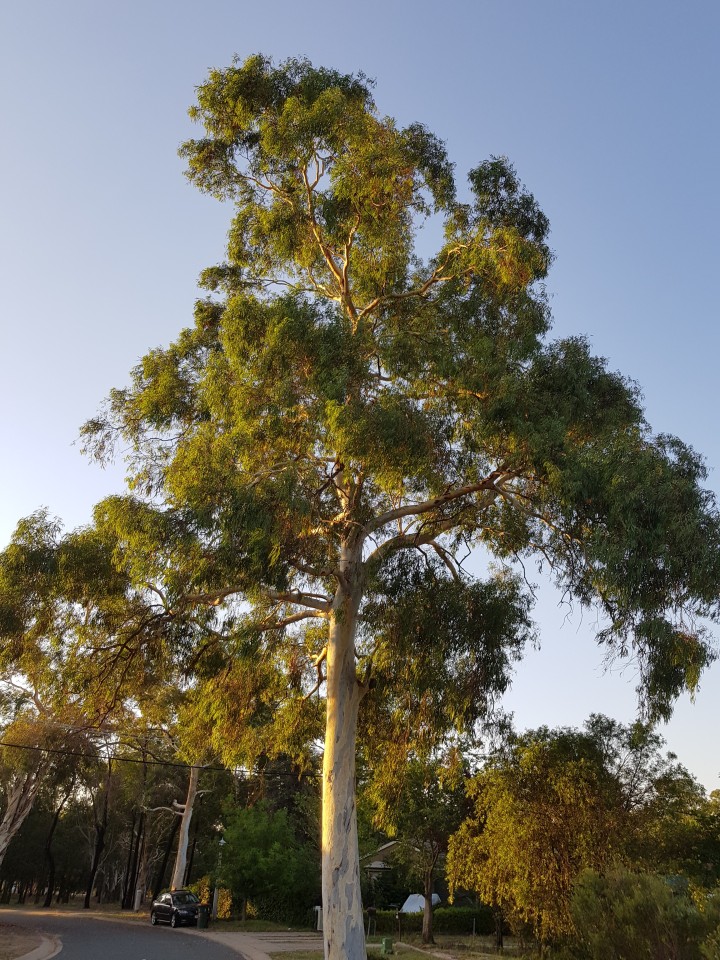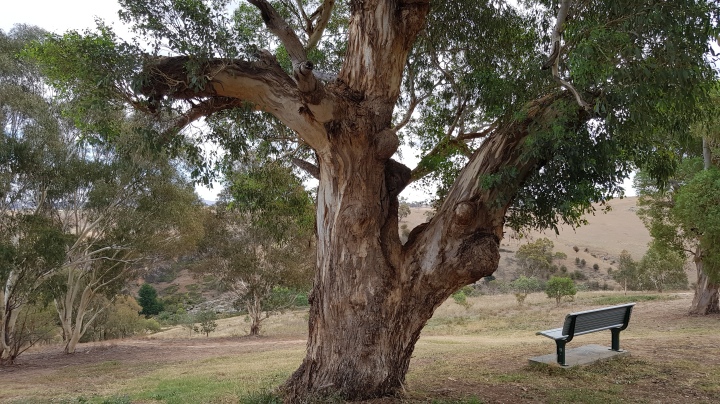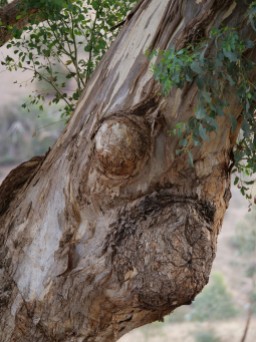Happy National Eucalypt Day, everyone. 23 March is the national day for Australia’s iconic eucaplypt trees, of which there are around 900 species. Eucalypts were known to have existed when Australia was still part of the super-continent Gondwana. The oldest known eucaplypt fossil specimens (flowers, fruit and leaves) date back 52 millions years!
Eucalypts fill me with wonder. My favourite childhood book was The Complete Adventures of Snugglepot and Cuddlepie by May Gibbs. It is the story of two gumnut babies. It is an Australian classic and obligatory reading.
The downside to eucalypts is the tendency for some to drop rather large limbs, giving them the unfortunate nickname of the Widow Maker. My own beautiful eucalyptus tree, the Brittle gum (Eucalyptus mannifera) may or may not have dropped one or two small limbs on my garden. I couldn’t say, as I have no wish for our council to chop it down. Needless to say, we don’t loiter under it. Isn’t it looking healthy? No doubt the roots are choking my drains. Ah well, it is the price I’m willing to pay.

If I was to post all my favourite eucalypt photos, we would be here all day, rather than enjoying the trees. So here is just one stately specimen. It has several beautiful burls which are prized by wood-workers.

And one more photo. Because I live in the bush capital. In summer, a haze of eucalyptus oil permeates the air.

Ahhhh, the wonder of it. Breathe. Relax. Repeat.
Kind Regards
Tracy
PS. I’m combining this celebration of the eucalypt with Frank’s Tuesday Photo Challenge — Wonder.


A fine object of celebration, Tracy. I love your image of the eucalypts’ mass ‘oily exhalation’ to the benefit of uplifted human noses. Ah, indeed.
LikeLiked by 3 people
Thank you, Tish. I love your description. 🙂
LikeLiked by 1 person
Your tree is gorgeous. I have only ever heard them called eucalyptus. When do you use eucalypt vs eucalyptus?
LikeLiked by 1 person
I think most Aussies use the term interchangeably. I know I do. I had to look it up. Thanks for the question, Heather. Now I know better. 🙂
Here is what the Australian National Botanic Gardens says on this issue:
“KEY FACTS ABOUT EUCALYPTS
Eucalypts are a defining feature of much of the Australian landscape and an essential part of Australian culture. They dominate the tree flora of Australia and provide habitat and food for many native animals. Of the over 850 eucalypt species known, almost all are native only to Australia. Some species have a wide geographic distribution; others are extremely restricted in their natural habitat and need conservation.
NOT ALL EUCALYPTS ARE EUCALYPTUS
The term ‘eucalypt’ refers to three closely-related genera of the Myrtaceae family – Eucalyptus with 758 species, Corymbia with 93 species and Angophora with 10 species.
Colloquially they are called ‘gum trees’. Eucalyptus is derived from the Greek eu- meaning ‘well’ and kalyptos meaning covered’, referring to the small cap or lid (operculum) which covers the flower
bud before it blooms in Eucalyptus and Corymbia. Angophora species have no flower bud cap. The name Angophora comes from the Greek phora meaning ‘carries’ and angos meaning ‘jar’ or ‘vessel’ refering to the cup-shaped fruit borne by members of the genus.
The genus Corymbia is named from the Latin corymbium; a ‘corymb’ refers to the form of the flower clusters. Eucalypts show a great diversity of size, form, leaf and bark type. Each of these characteristics help in their identification.”
LikeLiked by 2 people
Wow, thanks for looking that up! That is interesting. What an amazing world we live in. I never imagined so many species of Eucalyptus, never mind Eucalypts!
LikeLiked by 2 people
Blogging is better than going to school, Heather. 🙂
LikeLiked by 3 people
Hee hee! I suppose, it has us digging deeper at the time of interest!!
LikeLiked by 1 person
I love them too. They have been planted in China and when I moved to San Diego, they were there, too. It made me very happy.
LikeLiked by 2 people
It is interesting how they have made their mark in the world. I read recently that eucalypts were brought to California during the California Gold Rush, and because the climate was similar, they did well. But they do like fire and some think they make fires worse. But then again, if fires are going to happen anyway, it is good to have a tree that re-generates. I guess too that it is very good hardwood for the timber industry and some grow more quickly than many northern hemisphere trees.
LikeLiked by 1 person
They do make fires worse, but the wood also burns very hot in a wood stove because of all the oil in the wood. They turned out to be very invasive in California, besides the high fire risk — high in like these trees are tall. Lots of the native plants in the California chaparral also need fire and regenerate from the roots and the seeds of the Redwood tree can’t grow without fire.
LikeLiked by 1 person
They are very weedy in a lot of countries. Sorry, Martha. We do get very nervous when the sun blazes and the wind blows a gale. In my mind’s eye, the trees of the chaparral are small in stature. Although, redwoods definitely aren’t. Not sure why I have that image in my head.
LikeLike
Chaparral trees are short. Redwoods grow all the way down to San Diego, but they’re pretty rare. Originally fires in Southern California were seldom more than 15 feet high in the chaparral, but thanks to the Eucalyptus, they are higher and more dangerous. Well, it’s not the eucalyptus’ fault. I don’t mean that. ❤
LikeLiked by 1 person
I know what you mean. ❤
LikeLike
Beautiful trees. I love the scent of eucalyptus and the thought of it permeating a whole area 😀
LikeLiked by 1 person
I’m lucky to live in an area where a lot of eucalypts were planted when the suburb was first established (in the 70s). Our native trees do not seem to be much in favour in the newer suburbs where maples and deciduous trees are preferred.
LikeLiked by 1 person
That seems a bit crazy to me. But it’s a similar situation here, perhaps because a lot of our natives are quite slow-growing and developers want to cover up the scarred earth as quickly as possible.
LikeLiked by 1 person
We have a new suburb going up next to us, Su. We used to be on the fringe, but won’t be any longer. I’m going to write to the developers, and send them a few brochures from my favourite native plant nursery. Perhaps the brochures, and info on growing a bird friendly garden, could be part of the materials that each of the new owners receives.
LikeLiked by 2 people
That would be fantastic Tracy. We also used to be on the edge of the city, and surrounded by native bush. Now there is almost none left. I wish I’d thought of your idea!
LikeLiked by 1 person
Probably won’t achieve anything, Su. But at least I tried.
LikeLiked by 1 person
That’s all any of us can do (and more than most do!)
LikeLiked by 1 person
I love being around trees and eucalypts are no exception! The gumnut babies are so cute and fun to read to a group of children.
LikeLiked by 1 person
Kids love that story, Suzanne. Years ago, when I read that story to my young son, I was very surprised at how sophisticated the language was. Not dumbed down at all.
LikeLiked by 1 person
In a previous life I was a Kindergarten teacher, which meant I got to read numerous stories over and over 😊
LikeLiked by 1 person
🙂
LikeLiked by 1 person
Eucs all over the area where I live – Orange County, Southern California. I’ll have to see if I can find the story about the gumnut babies love the title.
LikeLiked by 1 person
I understand that our Eucs were imported into California during the California gold rush.
It would be nice if you could track down a copy of the story, Sharon. I’m not sure if it is still in print. But you definitely need a hard copy version, because the book has amazing illustrations.
LikeLike
Magnificent tree! Yes I love them too. I also love photographing the bark which I think is always interesting.
LikeLiked by 1 person
Haha. I had too many bark photos to choose from.
LikeLiked by 1 person
I know exactly what you mean! lol
LikeLiked by 1 person
Canada has ten species of native Maple Trees. One type of Maple growing in Eastetn Canada Is tapped in the spring and its sap is collected and a variety of candies and syrups are produced. The Maple Tree is Canada’s national tree and its distinctive leaf is on our national flag. Have you tried maple syrup and maple candy?
LikeLiked by 1 person
Genuine Canadian maple syrup is very difficult to find here. And very expensive. As it should be. We mostly get maple-flavoured syrup. Yuck. But yes, I have had the good stuff. Not maple candy though. Is that like toffee, only more delicious?
LikeLike
It can be a toffee or a fudge or a cream filling in a chocolate or as a flavouring in real ice cream. Ironically real ice cream with real maple flavour is hard to find here. We tend to find only the synthetic flavouring and synthetic ice cream which is a travesty.
LikeLiked by 1 person
Absolutely.
LikeLike
National Eucalypt Day- Well I have to admit I didn’t know we had a day for them but they deserve it. I was admiring the ones I can see from my house just yesterday. I don’t know what variety they are but they are home to the kookaburras I often hear and occasionally see. When I first discovered them as a child I was very taken with the bark. If I found large enough bits on the ground I liked to try to write on them.
A local church near my house used to have a row of them in the grounds. I’d go there to clean the church and I always felt a little uneasy when they creaked as I’d heard the stories about them dropping branches. Then one day one of them did. Of all the times of the week, it happened on Sunday morning when the congregation was inside. Nobody was hurt but a car was damaged. Sadly after that, they had the lot cut down. I think they were worried about their insurance.
LikeLiked by 1 person
That is a shame. Insurance seems to be a factor in many tree removals. i have seen and heard a few big limbs drop, Scary.
LikeLiked by 1 person
I worked with a woman whose father had been a timber cutter and who ran a timber business, he wasn’t killed on the job so to speak, but was killed by a widow maker in his timber yard! In the business eucalypt is often used as a singular 🙂 Strangely I never knew we had a day for eucalypts, so thank you Tracy.
LikeLiked by 1 person
I think it is a relatively new day, Paul.
You are making me nervous about my tree, Paul. We have a large lateral limb growing over our yard. But I figure if I cut this tree down, then I could go hiking tomorrow and another tree fall on me, so might as well leave it be.
LikeLiked by 1 person
Cue the scary music, lol, yes who knows. Sorry to make you nervous 🙂
LikeLiked by 1 person
Great photos! Thanks for sharing!
LikeLiked by 1 person
And thank you for stopping by.
LikeLike
I love the light in that first photo.
LikeLiked by 1 person
It’s all natural. 🙂
LikeLiked by 1 person
There are even a couple of eucalypts in Berlin! I was very surprised one summer when I went to our Central State Library and suddenly smelled cough drops. 😉 I didn’t know about them throwing off their limbs, will keep that in mind next time I come near one. 😄
LikeLiked by 1 person
Glad you know now, Sarah. Don’t want you to be caught unawares. 🙂
LikeLiked by 1 person
Now I’m wondering if they might drop some koala too? In that case I would risk standing under one. 😉
LikeLiked by 1 person
That’s why the koala’s nickname is drop bears. 🙂
LikeLiked by 1 person
LOL! Just read about the drop bears – they do look a bit like vampire koalas!! 😉 Just awesome! And I love the tricks you can use to repel their attack, like using toothpaste or veggie mite – I’d also ran when near veggimite!! 😀
LikeLiked by 1 person
You’re so funny, Sarah.
LikeLiked by 1 person
😉
LikeLike
Oh my, Tracy, this is an awesome post! I love it. I never knew there was a National Eucalypt Day. And thanks for sharing your beautiful photos. Keep well. -Dominique
LikeLiked by 1 person
Thank you, Dominque. I’m glad you enjoyed my photos. I think of you and your team whenever I take my nature photographs, especially the insects, because there is nothing they cannot teach us about beauty and style. Kind regards. Tracy.
LikeLiked by 1 person
What a lovely and kind thing to say. This comment goes straight to my heart. Thank you so much. And I totally agree with you Tracy. Keep well.
LikeLiked by 1 person